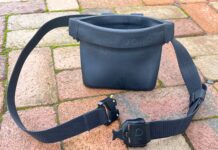I don’t know about you, but my Facebook news feed is often cluttered with posts regarding lost dogs. In the past week alone, friends or family shared photos and information about half a dozen different lost dogs, from all different parts of the country and lost due to all sorts of circumstances. I find these posts doubly sad, because not only are the people bereft for the loss of their dogs (and the dogs unquestionably scared out of their minds, cold, and hungry), many of the incidents described appear to have been avoidable – with hindsight, of course. But the point is, if people thought more about the bad things that can happen when they least expected them, and worked to prevent them, many of these tragic “lost dog” cases would never happen.
For example, there is a California family looking for their dog, who slipped his collar in the middle of being attacked by a loose dog on a walk, and who ran away in terror from his attacker and his family. While it’s arguable that attacks by loose dogs can’t have been prevented, what is certain is that if your dog’s collar can slip over his head in ANY circumstances, you need to walk him with a different type of collar or harness on! Well-fitted limited-slip collars (a.k.a. martingale collars) are best for many dogs with slender heads and thicker necks.

A well-adjusted and secure harness may be best for dogs whose neck and body anatomy (such as stocky Pugs) make any collars too risky.
I see many, many posts describing lost dogs with no collars (and therefore, no tags) on, which detail a variety of non-emergency reasons the dog was not wearing his or her collar (meaning, the dog didn’t slip the collar in a panic, but rather, wasn’t wearing a collar at the time of his or her escape). As long as gates can be left open, doors can be incompletely closed, a car accident can happen, and so on and so forth, your dog should have a collar on. However, second lines of defense are smart to employ with any dog who has a propensity to wander, or who is a flight risk when frightened. Securing a baby gate outside your main traffic doors or setting up exercise pens inside or outside the door in an “airlock” formation can prevent a door-darter from being rewarded by a quick (and risky) taste of freedom. And of course, car seat belts (or crating your dog in a car) are a great method for both protecting your dog from escaping your car after an accident and making certain he doesn’t bolt out of the car when the driver or passengers enter or exit.
One of the very first behaviors I begin to teach any of my own dogs or foster dogs is a recall, and I practice this behavior a LOT, in an effort to keep it super fresh and super reinforcing for my dogs. I almost always carry treats on a walk with dogs – and if a dog I am walking is new to me, and/or if the place I am walking is extra-challenging (for example, somewhere we might encounter deer or rabbits, or in town, where we have to pass by highly aroused dogs on the other side of fences) – I carry extra-special, over-the-top yummy treats, such as sardines or fresh roast beef.

Alternatively, I carry favorite toys for any toy-obsessed dogs I walk with. And I practice with dogs on a short leash in a low-distraction environment before graduating to a long line in a low-distraction environment; a short leash in a higher-distraction environment before moving up to a long line in a higher-distraction environment… you get the idea.
Also, if I’m not feeling really positive about the dog’s demonstrated ability to return to me brightly and quickly in any circumstances, I make darn sure the dog is never, ever completely “free.” He’s either on a leash, or in a secure crate, house, kennel, or yard until he’s demonstrated a SOLID recall in the face of all sorts of distractions.
Please! Fewer “lost dog!” postings, and more, “Wow, that (collar, crate, seatbelt, training) really paid off!” stories.






